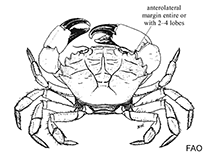Rhithropanopeus harrisii (Gould, 1841)
Harris mud crab| Native range | All suitable habitat | Point map | Year 2050 |

|
| This map was computer-generated and has not yet been reviewed. |
| Rhithropanopeus harrisii AquaMaps Data sources: GBIF OBIS |
Upload your photos
Google image | No image available for this species;
drawing shows typical species in Panopeidae.
Google image | No image available for this species;
drawing shows typical species in Panopeidae.
Classification / Names Common names | Synonyms | CoL | ITIS | WoRMS
Malacostraca | Decapoda | Panopeidae
Environment: milieu / climate zone / depth range / distribution range Ecology
Benthic; brackish; depth range 0 - 43 m (Ref. 108755). Temperate
Distribution Countries | FAO areas | Ecosystems | Occurrences | Introductions
Eastern Pacific and Western Atlantic: North America, Canada to Brazil.
Length at first maturity / Size / Weight / Age
Maturity: Lm ?, range 0 - 0.55 cm Max length : 2.0 cm CW male/unsexed; (Ref. 79470); max. reported age: 2.00 years (Ref. 109497)
Euryhaline. Prefers brackish waters, found in estuaries or quasi-freshwater lakes. Lives in muddy or sandy substrates, as well as on oyster reefs, vegetation, logs and manmade debris (Ref. 108786). Also on rubble (Ref. 97531). Omnivorous scavenger (Ref. 108786).
Life cycle and mating behavior Maturity | Reproduction | Spawning | Eggs | Fecundity | Larvae
Life cycle: It undergoes four (4) zoeal stages and one (1) megalopa before turning into adult (Refs. 79470, 109437, 109442, 109461). Mating behavior: Precopulatory courtship ritual is common (through olfactory and tactile cues); usually indirect sperm transfer (Ref. 833). Spawning occurs from July to August in northern latitudes, April to September in mid latitudes, and April to November in southern latitudes (Ref. 109493). Females burrow in the sand to lay eggs prior to copulation, brooding takes 15-19 days (Ref. 109502).
Main reference
References | Coordinator | Collaborators
Hill, M., R. Baker, G. Broad, P.J. Chandler, G.H. Coop, J. Ellis, D. Jones, C. Hoyland, I. Laing, M. Longshaw, N. Moore, D. Parrott, D. Pearman, C. Preston, R.M. Smith and R. Waters. 2005. (Ref. 1314)
IUCN Red List Status (Ref. 130435)
CITES status (Ref. 108899)
Not Evaluated
CMS (Ref. 116361)
Not Evaluated
Threat to humans
Human uses
| FishSource |
Tools
More information
Internet sources
BHL | BOLD Systems | CISTI | DiscoverLife | FAO(Publication : search) | Fishipedia | GenBank (genome, nucleotide) | GloBI | 1 GoMexSI (interaction data) | Google Books | Google Scholar | Google | PubMed | Tree of Life | Wikipedia (Go, Search) | Zoological Record
Estimates based on models
Preferred temperature
(Ref. 115969): 7.2 - 22.9, mean 14.2 (based on 234 cells).
Resilience
(Ref. 69278):
High, minimum population doubling time less than 15 months (K=1.28; tmax=2).
Price category
(Ref. 80766):
Unknown.



